There are different types of anaconda snakes are living around the world. Anaconda snakes are mainly living in South America forests. If humans too close to anacondas, then they may attack and eat humans too. So, be careful with anacondas and stay away for these type of snakes. The anacondas length is up-to 30 to 40 feet. There are 4 recognized species of anacondas are in the world. They are
- Green anaconda
- Yellow anaconda or Paraguayan anaconda
- Dark spotted anaconda
- Bolivian or Beni anaconda.

Anaconda Snakes are the apex predators of both small and large mammals. Though slow on land but they are extremely very fast and lithe under water. They are cold-blooded like all the other snakes. They are also catch large fish and turtles. They can also survive in the wide range of habitats and climates.
Anaconda Snakes use their advanced chemosensory abilities to detect their surroundings. They use their tongue to pick up the chemical signals which was in the air. During breeding season, male Anaconda Snakes detect the presence of female Anacondas by sensing their pheromones. They also have the pit organs in their upper lip which are useful to detect heat signatures.
Anaconda snakes were used to spend most of their time near the edge of a river. It will wait to catch their food when it was spotted then it will catch the target with their razor-sharp teeth and drag it into the water. This can cause the target to drown if it is not dead. Once they have suffocated, then the anaconda snakes will swallow its target from the beginning with the head.
Green Anaconda Snakes
The green anacondas has a narrow head with orange-yellow stripes and a huge green body. Its eyes are set on the top of the head and it can stay in water. While it is not that dangerous, but it can still scare you. It can reach up-to the length of 5.21m (17 feet 1 inch) long. The adult female length is up-to 5m (16feet 1 inch). The weight of Green Anacondas are from 30kg to 70kg in a typical adult.

Green anaconda snakes are mostly aquatic snakes they mostly eat aquatic creatures. The Anacondas mouth was up to three times bigger than its body and it can catch very huge animals easily. This snake can listen very keen sounds also very well and can make hissing noises when it senses a predator. They spend their most of the time near water, but can also eat land based animals.
It is also known as common Anaconda, Giant Anaconda, common water boa or sucuri are the boa species that are found in South America. It is a non-dangerous Snake like all boas. This snake is so large and muscular that it can stay without eating for months. The green anaconda snakes can swallow three times bigger than its own body weight. The size does make it an easy target to attack humans.
Yellow Anacondas
The yellow anacondas are also known as the Paraguayan anacondas. It is also a Boa species to South America. Yello anaconda snakes are one of the largest snakes in the world, but smaller than the Green Anaconda Snakes. There are no sub species recognized. It is non-venomous and kills by squeezing.
Anaconda snakes are not poisonous but they can bite & eat people. Most snakes inject poison into the creatures but anacondas do not do that. Instead, of that they use their body to suffocate and to kill and then release their coils.
Anaconda spends their time mostly in water hunting for their food. They eat fish, birds, and other animals such as deer and caimans. However, some have been reported to prey on sheep and humans.

Dark Spotted Anacondas
The dark spotted anaconda snakes are also known as Eunectes deschauenseei. It has species in the sub family called Boinae of the family Boidae. The native place for this species is Northeastern South America. It mostly occurs from autumn to spring. The Gestation lasts as long as nine months. The Litter size is among five gravid females range from 3 to 27. New born length is 29 to 53 cm long.

Anaconda Snakes eyes and nasal holes are located higher than those of other snakes. This helps them to hunt prey when they are submerged under the water surface. They have good eyesight and are well adapted to the low light. Anacondas can swim ten miles per hour. Their speed depends upon the species and their age. Some species can swim less than one mile per hour.
Anaconda snakes are mostly found in swamps, lakes, and rivers and they live in tropical South America. Its eyes and nostrils are located on top of their heads that can help them to see their prey without getting too close. They spend their lives in water and they can climb easily.
Bolivian or Beni Anacondas
- Bolivian anaconda snakes scientific name is Euncectes beniensis.
- The Bolivian anaconda is the species of Boa.
- It is from the northeastern parts of Bolivia.
- The Bolivian anaconda snake another name is Beni Anaconda.
- It is derived from the geographical location of its native habitat.
- It is non-venomous like all other boas.

